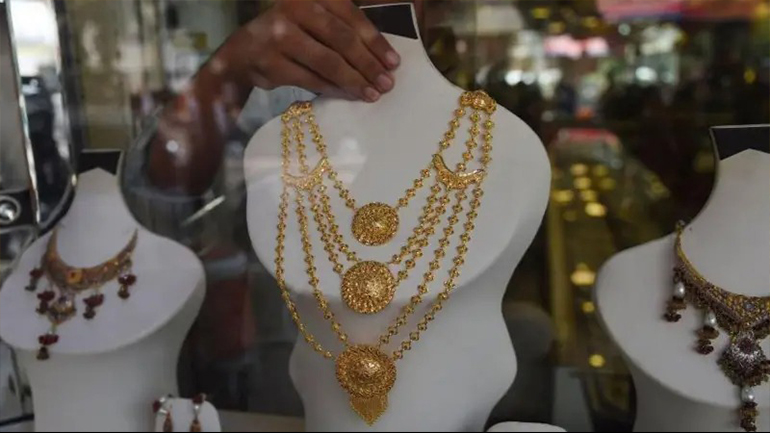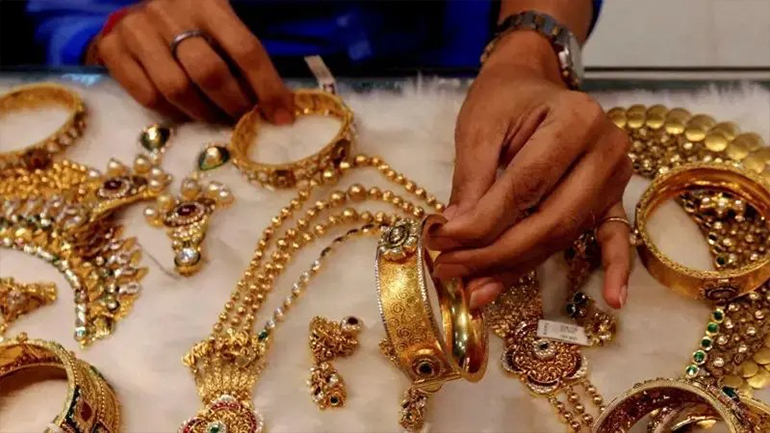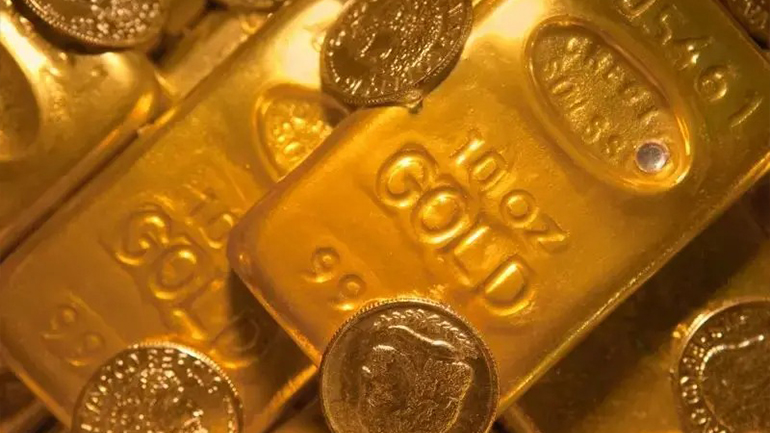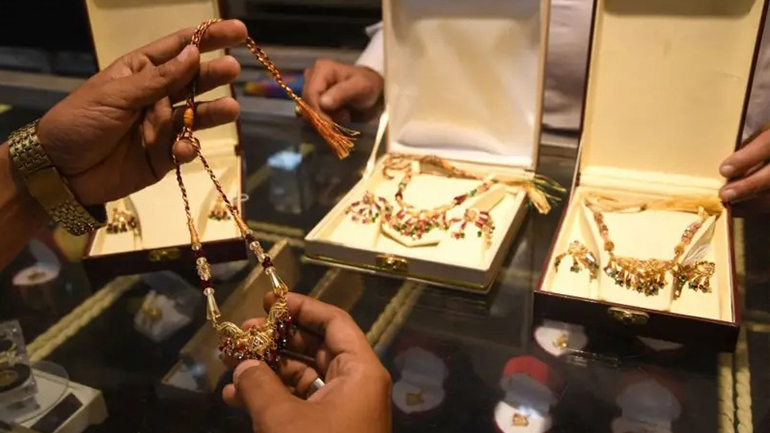

While the ongoing trade war between the United States and China has triggered a downturn in major stock markets across Asia and around the world, gold prices have begun to soar globally — including in Pakistan — reaching record highs. On Monday, Pakistan witnessed a major increase of Rs 8,100 per tola, bringing the gold price to Rs 357,800 per tola, the highest ever in the country’s history. According to the All Pakistan Sarafa Jewelers Association, the price of 10 grams of gold also surged by Rs 6,944, reaching Rs 306,755. Meanwhile, in the international market, gold prices rose by $69 per ounce, hitting $3,395 per ounce. This sustained rise in gold prices worldwide is driven by increasing economic uncertainty and intensifying trade tensions between the two global economic superpowers. As a result, investors — wary of the unpredictable stock markets — are increasingly turning to gold as a safer investment option. It’s worth noting that on January 1, 2025, the price of gold in Pakistan was Rs 272,600 per tola, which means it has surged by nearly 30% in just over three months. In recent months, the global surge in gold prices reflects investors’ shift toward safe-haven assets amid uncertain financial futures. Gold, long regarded as a dependable and tangible asset during times of crisis or instability, is once again becoming the preferred choice for those seeking secure investment opportunities. Gold is not only purchased for making jewelry but is also considered a safe investment around the world. Just like in other countries, gold investment in Pakistan is seen as a significant financial avenue alongside stock market and real estate investments. In times of economic uncertainty, gold is widely viewed as the safest investment option. In Pakistan, gold prices saw a slight dip toward the end of last year, but the trend has since reversed, with prices rising once again. Whether for weddings or to safeguard savings, many families in Pakistan traditionally purchase gold. However, over the past few years, the sharp rise in gold prices has made it increasingly unaffordable for the average person. Speaking to journalist Tanveer Malik, Abdullah Chand, Vice President of the Jewellers Association of Tariq Road — an upscale area of Karachi — said that gold has long become a dream for low-income individuals in Pakistan. Now, even the middle class is struggling to afford it. “Only the wealthy can now afford gold, and even they are shifting away from heavy jewelry pieces to lighter designs,” he remarked.

Gold jewelry has not only cultural but also religious significance in different countries of the world.
In the international market, precious metals and materials are weighed using the Troy ounce system, where one ounce equals 31.1 grams. Currently, the international gold price stands at $3,395 per ounce. Experts and traders involved in the gold trade in Pakistan attribute the surge in domestic gold prices to rising global rates. The London Bullion Market is the primary global platform for determining gold prices. Mohammad Qasim Shakarpuri, President of the All Pakistan Sarafa Jewelers Association and Chairman of the Karachi Bullion Exchange, told journalist Tanveer Malik that this price hike is primarily the result of the intensifying trade war between the US and China, especially after the imposition of new tariffs, which has further escalated tensions. He stated that neither side appears to be backing down, which is raising concerns of a prolonged global economic slowdown, prompting investors to turn to gold as a safe haven. According to Shakarpuri, “The demand for gold has increased worldwide as it has become a reliable hedge against currency devaluation and economic uncertainty.” He also noted, “Investors are active, but there is a shortage of gold in the market. There are plenty of buyers, but very few sellers.” Gold dealers suggest that due to ongoing global economic uncertainty, central bank gold purchases, and increased demand for safe investments, gold prices are expected to continue rising in the coming weeks. Abdullah Chand, Vice President of the Karachi Jewelers Association, echoed similar sentiments, linking the global rise in gold prices to the policies of US President Donald Trump since he took office. He explained that before Trump assumed power, there was hope he would help reduce global tensions. However, the opposite occurred as he introduced new tariffs, igniting a trade war, which in turn influenced gold prices. “In times of uncertainty, investors perceive gold as a safe investment,” he said. “In recent weeks, we've seen a surge in gold investments globally, resulting in a sharp increase in prices.”

This precious metal has traditionally been seen as a reliable, solid asset in times of financial hardship or instability.
Gold prices often rise during periods of instability. When financial markets tumble, a sudden "gold rush" can occur as a large number of buyers rush to acquire this precious metal. In Pakistan, the current economic situation is far from encouraging. People's incomes have declined, while gold prices have skyrocketed. In such circumstances, gold sector expert Ahsan Ilyas stated that there is no such thing as a "bad time" to invest in gold. Looking at the trend over the past five to six years, gold prices have shown a consistent upward trajectory. He noted that six or seven years ago, the price of gold was around PKR 50,000 per tola, whereas now it has reached PKR 357,800 per tola. On an annual average, gold has yielded steady returns. According to him, gold remains a safe investment and has never resulted in a loss for investors. With gold prices currently at an all-time high in Pakistan, Abdullah Chand pointed out that investing in gold is no longer viable for the middle class—only the wealthy can afford to do so now. He added that gold investment should be viewed as a long-term strategy, as it typically yields better returns over time. “Gold offers the best value to investors because it is like having hard cash. You can sell it anytime, even in the middle of the night, if needed,” he said. Ahsan Ilyas also emphasized that investment in gold should always be for the long term, as that's where real returns lie. He warned that money invested in gold for the short term isn’t truly an investment—it’s speculation, which comes with no guarantees. Given the economic instability in Pakistan, starting a business or making investments is a major challenge. In this context, Ahsan Mehanti, a metals and commodities expert from Arif Habib Corporation, explained that the sharp depreciation of the Pakistani rupee over the past few years has significantly increased inflation. According to him, investing in gold during this period helped counter the negative impact of inflation. He also added that with rising geopolitical tensions and conflicts in many regions around the world, gold is widely seen as a safe-haven investment.
 Gold has traditionally been the simplest choice when there is global uncertainty in the financial market.
Gold has traditionally been the simplest choice when there is global uncertainty in the financial market.
Dr. Philip Flyers, an economic historian from the University of Belfast, says, "Governments and individual investors are offloading shares on a large scale and turning to gold." He adds, "And that is truly the reason behind the increase in its prices." When there is global uncertainty in the financial markets, gold traditionally remains the simplest choice. In 2020, the COVID-19 pandemic triggered an economic crisis, causing a sudden spike in gold prices. However, uncertainty in the financial markets can also affect gold. In January 2020, as the COVID-19 outbreak began to spread, gold prices surged. But by March of the same year, they began to decline. Dr. Flyers says, "It is a safe investment, but that doesn’t mean it is completely risk-free." Still, gold is widely regarded as a secure investment—not only because of its value, but also due to its historical significance and high regard across various cultures, which makes it an easily tradable asset.
If gold prices continue to rise, many people might consider selling their gold. However, experts believe that such a move should be avoided. On this topic, Ahsan Ilyas stated that gold prices are currently on the rise, and people tend to think that when prices increase, it’s the right time to buy, and when prices drop, they rush to sell. He explained, “This mindset is not correct. The ideal approach is to invest in gold when prices decline.” If we examine trends in both Pakistan and the global market, gold prices have shown a consistent increase over the past 20 years. One of the reasons behind this is the rising demand for gold in the market. Abdullah Chand commented that there is little chance of a decline in gold prices, and they are expected to rise further in the future due to international conditions. He pointed out that central banks in developed countries are buying gold, led by the U.S. Federal Reserve, which is actively purchasing gold. This indicates that in times of global uncertainty, investing in gold remains the safest investment option.
There is no centralized system in Pakistan to track the buying and selling of gold, which makes it difficult to gather annual data on gold transactions. However, according to experts associated with the gold sector, Pakistan's annual demand for gold is estimated to be around four tonnes. Ahsan Mehanti explained that this annual demand of four tonnes includes gold purchased for both trade and weddings. Regarding gold imports in Pakistan, he stated that the State Bank's regulations and other regulatory requirements are quite strict. As a result, official channels bring in less gold, and people often resort to alternative sources for importing it. According to data from the Pakistan Bureau of Statistics, 277 kilograms of gold were officially imported during the first six months of the current fiscal year. Ahsan Mehanti noted that while these are the official figures, additional gold enters the country through unofficial routes such as the Pakistan-India and Pakistan-Iran borders.

However, gold is still considered a safe investment, not only because of its value, but also because of its great value in history and across cultures, and because it is easy to trade.
From Tutankhamun’s golden mask of ancient Egypt to the Golden Stool of the Ashanti in Ghana and the golden throne of the Padmanabhaswamy Temple in India, gold has historically held deep religious and symbolic significance. It is no surprise that many people view gold as a reliable way to store wealth. The value of gold items and jewelry kept at home is often unaffected by fluctuations in global financial markets. However, any major investment can still be at the mercy of actions taken by large financial institutions. Referring to the recent spike in gold prices, Dr. Flyers notes, “I suspect a major reason is the central banks of governments buying gold.” “They often purchase gold on a large scale to boost their reserves because they move away from equity investments during uncertain times.” This means that investing in precious metals can carry its risks. Dr. Flyers says that speculating on rising gold prices remains a risky strategy, because “as soon as markets stabilize and governments come to their senses, people will move away from gold again.” “I would say that gold investment is something you do for the long term,” he adds.
In Pakistan, it is common to give and wear gold jewelry as gifts during weddings and various ceremonies, which is why the recent rise in gold prices has sparked a public reaction. Many consumers believe that, in light of the recent price hike, the government should enact laws to stop the tradition of giving gold jewelry at weddings. Regarding the increase in gold prices, Muhammad Imran believes, “Wealthy countries are buying gold in bulk from the international market, which is why gold prices have already moved beyond the reach of the middle class.” He adds, “I think gold prices won’t stop until they hit five lakh rupees per tola.” In response to complaints about the rising gold prices in Pakistan, Safia Saeed writes, “Gold prices are already skyrocketing in the international market, and this has nothing to do with any single country. In my opinion, the real issues for the public are utility bills, petroleum prices, daily essentials, and medicine costs... Gold is a luxury, and life can go on without it.”
Powered by Froala Editor